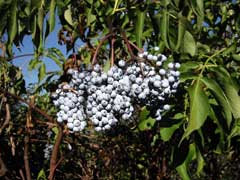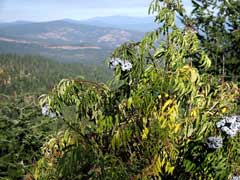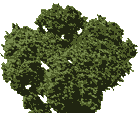 |
|
http://commons.wikimedia.org/wiki/User:Wsiegmund |
 |
| http://commons.wikimedia.org/wiki/User:Wsiegmund |
Translate this page:
Summary
Sambucus caerulea, or Blue Elder Shrub, produces edible fruit that can be eaten raw, cooked, dried, or used in preserves. It is considered the best-flavored North American elder, though somewhat rank when fresh, and is often dried before consumption. The flowers are also edible, used in fritters or made into a pleasant tea. This fast-growing but short-lived tree thrives in various soils, including chalk and heavy clay, preferring moist loamy conditions and tolerating pollution, coastal exposure, and partial shade. Highly resistant to honey fungus, it is valuable in agroforestry for attracting pollinators, supporting wildlife, and controlling erosion when planted in riparian zones. The berries provide food for birds and small mammals, while the dense foliage offers nesting sites and overwintering shelter for insects. Though it does not emit a strong pest-repelling scent, dried flower stems can deter insects and rodents, and a leaf decoction repels caterpillars. Traditionally, its hollow stems have been used for making flutes and fire tinder, while its soft, coarse-grained wood has limited commercial use but is locally utilized for small items like skewers and pegs. While partially self-fertile, cross-pollination improves fruit yield. Though beneficial in many ways, some caution is advised due to mild toxicity concerns.
Physical Characteristics

 Sambucus caerulea is a deciduous Shrub growing to 3 m (9ft 10in) at a medium rate.
Sambucus caerulea is a deciduous Shrub growing to 3 m (9ft 10in) at a medium rate.
See above for USDA hardiness. It is hardy to UK zone 5. It is in flower from June to July, and the seeds ripen from August to September. The species is hermaphrodite (has both male and female organs) and is pollinated by Insects. The plant is self-fertile.
It is noted for attracting wildlife.
Suitable for: light (sandy), medium (loamy) and heavy (clay) soils and can grow in heavy clay soil. Suitable pH: mildly acid, neutral and basic (mildly alkaline) soils. It can grow in semi-shade (light woodland) or no shade. It prefers dry or moist soil. The plant can tolerates strong winds but not maritime exposure.
It can tolerate atmospheric pollution.
UK Hardiness Map
US Hardiness Map
Synonyms
S. glauca. S. neomexicana.
Plant Habitats
Woodland Garden Sunny Edge; Dappled Shade; Shady Edge;
Edible Uses
Edible Parts: Flowers Fruit
Edible Uses: Tea
Fruit - raw, cooked or used in preserves[2, 3, 15, 85, 94, 183, 257]. Rather sweet and juicy but full of small seeds[82, 256], this is the best flavoured of the North American elders[212]. The fruit is rather nice raw, seven people ate and enjoyed a small quantity of the raw fruit with no ill effects[K]. The fruit can be dried for later use[257]. A somewhat rank taste fresh[101], the fruit is usually dried before being used[183]. The fruit is about 6mm in diameter and is borne in large clusters[200]. Some caution is advised, see the notes above on toxicity. Flowers - raw or cooked in fritters etc[15, 85, 94, 183]. Very pleasant and refreshing raw[K]. A pleasant tea is made from the dried flowers[62, 183].
References More on Edible Uses
Medicinal Uses
Plants For A Future can not take any responsibility for any adverse effects from the use of plants. Always seek advice from a professional before using a plant medicinally.
Analgesic Antiseptic Astringent Diaphoretic Emetic Febrifuge Haemostatic Laxative
Pectoral Salve Stomachic Tonic
Haemostatic[94]. An infusion or extract made from the flowers, bark and root has been used to cure fevers and gripe, it is also laxative[226]. A decoction of the plant has been used as an antiseptic wash to treat itches[257]. The bark is analgesic and astringent[257]. An infusion has been used in the treatment of diarrhoea and rheumatism[257]. A decoction has been used as a wash in the treatment of swellings and pain[257]. An ointment made by mixing the bark with fat has been used externally in the treatment of burns, ulcers, skin irritations etc[226]. The fresh bark has been placed in a tooth cavity to ease the pain of toothache[257]. The inner bark is strongly emetic[257]. The leaves are analgesic, antiseptic, diaphoretic, febrifuge and purgative[257]. A decoction has been used in the treatment of new colds[257]. An infusion of the leaves and flowers has been used as a steam bath in the treatment of colds and headaches[257]. A decoction of the leaves has been used as an antiseptic wash on limbs affected by blood poisoning[257]. The crushed leaves have been used as a poultice to treat burns and swollen hands[257]. A decoction of the root has been used in the treatment of bladder problems and dyspepsia[257]. A decoction of the flowers has been used in the treatment of stomach troubles and lung complaints[257]. Applied externally, it has been used to treat sprains and bruises and as an antiseptic wash for open sores and itches[257]. A wine made from the fruit has been used as a tonic[257].
References More on Medicinal Uses
The Bookshop: Edible Plant Books
Our Latest books on Perennial Plants For Food Forests and Permaculture Gardens in paperback or digital formats.

Edible Tropical Plants
Food Forest Plants for Hotter Conditions: 250+ Plants For Tropical Food Forests & Permaculture Gardens.
More

Edible Temperate Plants
Plants for Your Food Forest: 500 Plants for Temperate Food Forests & Permaculture Gardens.
More

More Books
PFAF have eight books available in paperback and digital formats. Browse the shop for more information.
Shop Now
Other Uses
Musical Repellent Tinder Wood
Agroforestry uses: Elderberry is beneficial in agroforestry for attracting pollinators and wildlife. It can be used as a hedge or windbreak and is often planted in riparian zones for erosion control. The flowers and berries are edible (with the proper preparation) and have culinary and medicinal uses. A decoction of the leaves, when watered on plants, repels caterpillars[94]. The dried flower stems repel insects and rodents[101]. The hollow stems can be used as flutes and pipes[257]. The pith of the stems has been used as a tinder for lighting fires[257]. Wood - light, soft, weak, coarse grained. Of no commercial value, though it is used locally for flutes, skewers, pegs, straws etc[82, 94, 99, 229]. 1. Nectary - Flowers rich in nectar and pollen:
Yes – Elderberry flowers are highly attractive to pollinators like bees and other insects due to their abundant nectar and pollen.
2. Wildlife - Food (Fruit, Seeds, Leaf litter, Shelter, Nesting, Roosting):
Yes – The berries are a valuable food source for birds and small mammals. The dense foliage and branching structure provide excellent cover and shelter for wildlife, and birds may nest within the shrub.
3. Invertebrate Shelter (Overwintering sites, Leaf litter, Groundcover):
Yes – The dense, shrubby growth provides overwintering habitat for insects. Leaf litter from elderberry can also provide ground cover for invertebrates.
4. Pest Confuser (Smell):
No – Elderberry does not produce a strong scent that would confuse or repel pests.
Special Uses
References More on Other Uses
Cultivation details
Tolerates most soils, including chalk[200], but prefers a moist loamy soil[11, 200]. Grows well in heavy clay soils. Tolerates some shade but is best in a sunny position[1]. Tolerates atmospheric pollution and coastal situations[200]. A fast-growing but short-lived tree in the wild[229]. A shrub at Kew in September 1993 was carrying a good crop of tasty fruits[K]. Plants in this genus are notably resistant to honey fungus[200]. Elderberry cultivars (Sambucus) are partially self-fertile, but cross-pollination can increase fruit production. Elderberries are usually harvested in late summer to early autumn, around August to September (Northern Hemisphere), when the berries are fully ripe.
Elderberry typically flowers in late spring to early summer, around May to June (Northern Hemisphere), producing clusters of small white or cream-colored flowers. Elderberry is a fast-growing shrub or small tree, reaching heights of 3 to 6 meters (10 to 20 feet) in a few years under optimal conditions. It prefers moist, well-drained soils and can thrive in a variety of environments, including disturbed areas.
References Carbon Farming Information and Carbon Sequestration Information
Temperature Converter
Type a value in the Celsius field to convert the value to Fahrenheit:
Fahrenheit:
The PFAF Bookshop
Plants For A Future have a number of books available in paperback and digital form. Book titles include Edible Plants, Edible Perennials, Edible Trees,Edible Shrubs, Woodland Gardening, and Temperate Food Forest Plants. Our new book is Food Forest Plants For Hotter Conditions (Tropical and Sub-Tropical).
Shop Now
Plant Propagation
Seed - best sown as soon as it is ripe in the autumn in a cold frame, when it should germinate in early spring. Stored seed can be sown in the spring in a cold frame but will probably germinate better if it is given 2 months warm followed by 2 months cold stratification first[78, 98, 113]. Prick out the seedlings into individual pots when they are large enough to handle. If good growth is made, the young plants can be placed in their permanent positions during the early summer. Otherwise, either put them in a sheltered nursery bed, or keep them in their pots in a sheltered position and plant them out in spring of the following year. Cuttings of half-ripe wood, 7 - 10cm with a heel, July/August in a frame[78]. Cuttings of mature wood of the current season's growth 15 - 20cm with a heel, late autumn in a frame or a sheltered outdoor bed[78].
Other Names
If available other names are mentioned here
Native Range
Coming Soon
Weed Potential
Right plant wrong place. We are currently updating this section.
Please note that a plant may be invasive in one area but may not in your area so it's worth checking.
Conservation Status
IUCN Red List of Threatened Plants Status :

Growth: S = slow M = medium F = fast. Soil: L = light (sandy) M = medium H = heavy (clay). pH: A = acid N = neutral B = basic (alkaline). Shade: F = full shade S = semi-shade N = no shade. Moisture: D = dry M = Moist We = wet Wa = water.
Now available:
Food Forest Plants for Mediterranean Conditions
350+ Perennial Plants For Mediterranean and Drier Food Forests and Permaculture Gardens.
[Paperback and eBook]
This is the third in Plants For A Future's series of plant guides for food forests tailored to
specific climate zones. Following volumes on temperate and tropical ecosystems, this book focuses
on species suited to Mediterranean conditions—regions with hot, dry summers and cool, wet winters,
often facing the added challenge of climate change.
Read More
Expert comment
Author
Raf.
Botanical References
1182200
Links / References
For a list of references used on this page please go here
Readers comment
| Add a comment |
|
If you have important information about this plant that may help other users please add a comment or link below. Only comments or links that are felt to be directly relevant to a plant will be included. If you think a comment/link or information contained on this page is inaccurate or misleading we would welcome your feedback at [email protected]. If you have questions about a plant please use the Forum on this website as we do not have the resources to answer questions ourselves.
* Please note: the comments by website users are not necessarily those held by PFAF and may give misleading or inaccurate information.
To leave a comment please Register or login here All comments need to be approved so will not appear immediately.
|
Subject : Sambucus caerulea
|
|
|
|